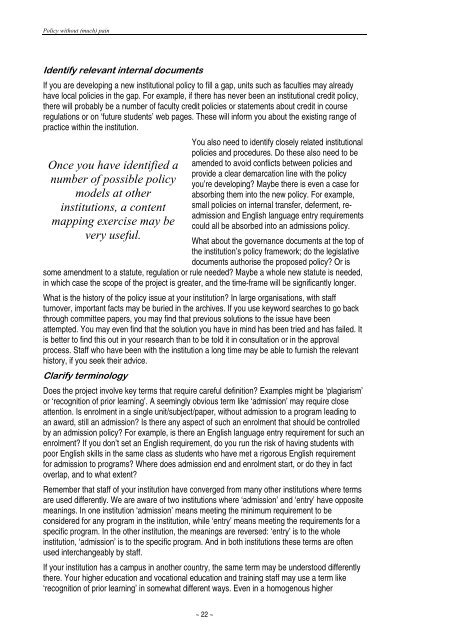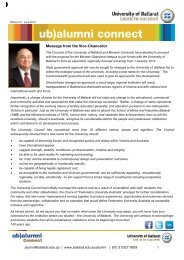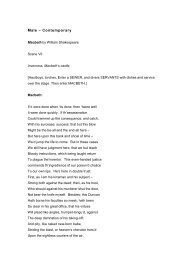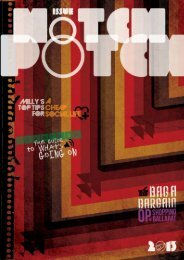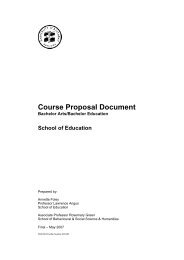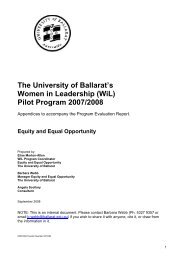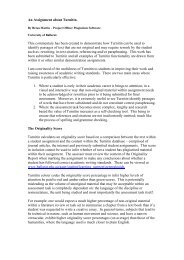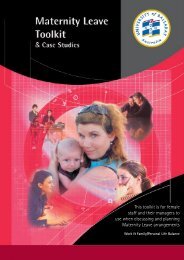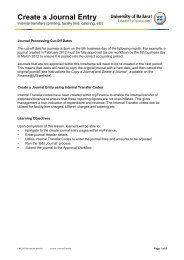Policy without (much) pain - University of Ballarat
Policy without (much) pain - University of Ballarat
Policy without (much) pain - University of Ballarat
- No tags were found...
Create successful ePaper yourself
Turn your PDF publications into a flip-book with our unique Google optimized e-Paper software.
<strong>Policy</strong> <strong>without</strong> (<strong>much</strong>) <strong>pain</strong>Identify relevant internal documentsIf you are developing a new institutional policy to fill a gap, units such as faculties may alreadyhave local policies in the gap. For example, if there has never been an institutional credit policy,there will probably be a number <strong>of</strong> faculty credit policies or statements about credit in courseregulations or on ‘future students’ web pages. These will inform you about the existing range <strong>of</strong>practice within the institution.Once you have identified anumber <strong>of</strong> possible policymodels at otherinstitutions, a contentmapping exercise may bevery useful.You also need to identify closely related institutionalpolicies and procedures. Do these also need to beamended to avoid conflicts between policies andprovide a clear demarcation line with the policyyou’re developing? Maybe there is even a case forabsorbing them into the new policy. For example,small policies on internal transfer, deferment, readmissionand English language entry requirementscould all be absorbed into an admissions policy.What about the governance documents at the top <strong>of</strong>the institution’s policy framework; do the legislativedocuments authorise the proposed policy? Or issome amendment to a statute, regulation or rule needed? Maybe a whole new statute is needed,in which case the scope <strong>of</strong> the project is greater, and the time-frame will be significantly longer.What is the history <strong>of</strong> the policy issue at your institution? In large organisations, with staffturnover, important facts may be buried in the archives. If you use keyword searches to go backthrough committee papers, you may find that previous solutions to the issue have beenattempted. You may even find that the solution you have in mind has been tried and has failed. Itis better to find this out in your research than to be told it in consultation or in the approvalprocess. Staff who have been with the institution a long time may be able to furnish the relevanthistory, if you seek their advice.Clarify terminologyDoes the project involve key terms that require careful definition? Examples might be ‘plagiarism’or ‘recognition <strong>of</strong> prior learning’. A seemingly obvious term like ‘admission’ may require closeattention. Is enrolment in a single unit/subject/paper, <strong>without</strong> admission to a program leading toan award, still an admission? Is there any aspect <strong>of</strong> such an enrolment that should be controlledby an admission policy? For example, is there an English language entry requirement for such anenrolment? If you don’t set an English requirement, do you run the risk <strong>of</strong> having students withpoor English skills in the same class as students who have met a rigorous English requirementfor admission to programs? Where does admission end and enrolment start, or do they in factoverlap, and to what extent?Remember that staff <strong>of</strong> your institution have converged from many other institutions where termsare used differently. We are aware <strong>of</strong> two institutions where ‘admission’ and ‘entry’ have oppositemeanings. In one institution ‘admission’ means meeting the minimum requirement to beconsidered for any program in the institution, while ‘entry’ means meeting the requirements for aspecific program. In the other institution, the meanings are reversed: ‘entry’ is to the wholeinstitution, ‘admission’ is to the specific program. And in both institutions these terms are <strong>of</strong>tenused interchangeably by staff.If your institution has a campus in another country, the same term may be understood differentlythere. Your higher education and vocational education and training staff may use a term like‘recognition <strong>of</strong> prior learning’ in somewhat different ways. Even in a homogenous higher~ 22 ~


